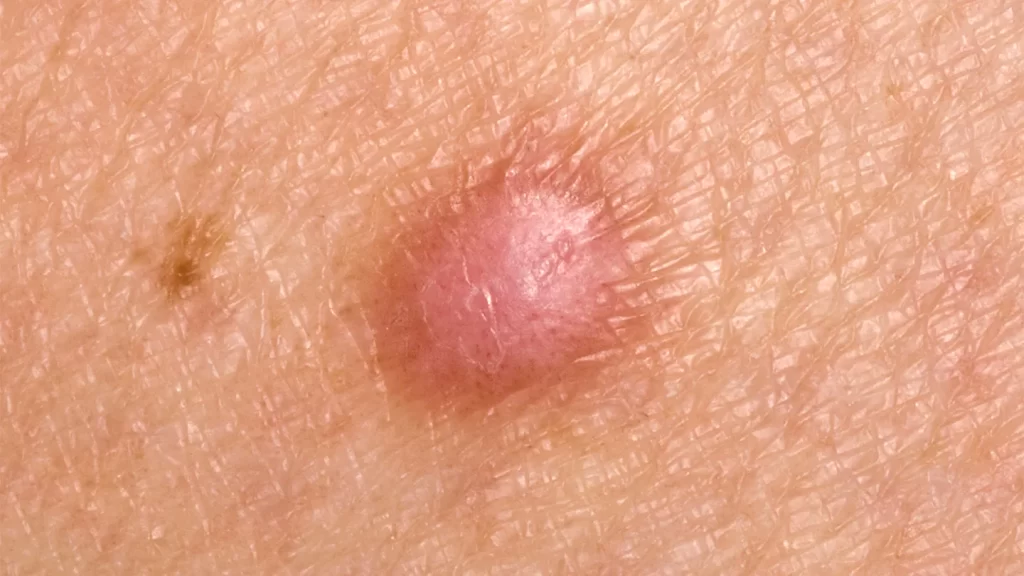Skin bumps may be caused by blocked follicles, allergies, infections, or more serious conditions like skin cancer. Dermatologists assess warning signs such as growth, color change, bleeding, or non-healing bumps.
With DermOnDemand, patients can quickly connect for a bump on skin dermatologist, guided by Dr. Hannah Kopelman – a board-certified expert in skin conditions and treatments.
Key Takeaways
- A bump on the skin can result from blocked hair follicles, allergic reactions, skin infections, or benign conditions like keratosis pilaris.
- Dermatologists can identify whether a bump is harmless or linked to serious issues such as basal cell carcinoma or squamous cell carcinoma.
- Warning signs include raised skin bumps that grow, change skin color, bleed, or fail to heal, and these require prompt medical review.
- Treatment options range from prescription creams to surgically removing suspicious growths, depending on the cause and severity.
- DermOnDemand, led by Dr. Hannah Kopelman, provides secure online evaluations and 24-hour treatment plans without the need for in-office visits.
Understanding Skin Bumps
Why do I have a random raised bump on my skin?
A raised skin bump can form for many reasons. It may come from clogged hair follicles, an allergic reaction, or a mild skin infection. Some bumps go away on their own, while others may signal an underlying skin condition that needs care.
Common harmless skin bumps
Many bumps are common skin changes. Examples include keratosis pilaris, which causes small rough spots on arms and legs, and blocked oil glands that form tiny lumps under the skin. These bumps are usually harmless but may cause cosmetic concerns.
Round raised bump on skin.
A round raised bump often comes from cysts or benign growths. These can develop anywhere on the body and may feel firm or soft. While many are harmless, monitoring changes in size, color, or pain is important to rule out more serious causes.
Small bumps on the skin are not itchy.
Small bumps that are not itchy may result from blocked skin cells or harmless skin growths. They often appear flesh colored and can be left untreated unless they change or become irritated. A dermatologist can confirm the cause with a quick evaluation.
Tiny, colorless, itchy bumpsonn the skin
Tiny, clear or colorless bumps that itch may point to allergic reactions, mild eczema, or irritation from sun exposure. They can appear on arms and legs or anywhere on the body. Identifying the trigger helps prevent flare-ups and guides treatment options.
When to See a Dermatologist

Should I go to a dermatologist for a bump?
Yes. A dermatologist can tell the difference between harmless and concerning bumps. A professional exam ensures the right diagnosis and helps you access safe treatment options.
Warning signs in raised skin bumps
Seek medical care if a bump grows quickly, changes skin color, bleeds, or becomes painful. Raised skin bumps with irregular edges or that do not heal may be linked to skin cancer. Early review by a dermatologist is essential.
Persistent bumps that don’t heal
A bump that lasts for weeks without improvement should not be ignored. In some cases, conditions like basal cell carcinoma or squamous cell carcinoma can look like common bumps but carry health risks. A quick exam can provide peace of mind.
Conditions and Causes Dermatologists Treat
Raised skin bumps from acne, eczema, or rosacea
Dermatologists often treat bumps caused by acne, rosacea, or eczema. These conditions may cause redness, swelling, or raised skin that persists without care. Prescription treatments can reduce inflammation and restore clear skin.
Cysts, lipomas, and skin cancer bumps
Cysts form when oil glands or skin cells are trapped, creating firm lumps. Lipomas are soft fatty growths that feel rubbery.
More concerning are bumps linked to skin cancer, such as basal cell carcinoma, which often appears as a shiny bump, or squamous cell carcinoma, which may look scaly. A dermatologist can identify these conditions and recommend safe next steps.
Diagnosis and Treatment
Can a dermatologist diagnose and remove skin bumps?
Yes. A dermatologist can diagnose the cause of a bump with a physical exam or biopsy. If needed, they can surgically remove growths in a safe and controlled setting. This is often recommended for suspicious or bothersome bumps.
Prescription-grade treatments available online
DermOnDemand provides treatment options without waiting rooms. After you share your details, a dermatologist reviews your case and creates a plan within 24 hours. Prescription creams or oral medications are shipped directly to your home for convenience.
Bumps on skin pictures: How doctors evaluate
Pictures of skin bumps can help dermatologists understand the issue. Clear photos show size, color, and changes over time, helping doctors decide if a condition is a common skin issue or if more testing is needed.
Why Online Dermatology Is Faster

No waiting rooms, 24-hour plans
With DermOnDemand, patients avoid long waits. Care is delivered online, and most patients receive a treatment plan in less than a day. This model suits busy schedules and urgent skin concerns.
Secure, discreet prescriptions delivered
All care is confidential. Prescriptions are reviewed by board-certified dermatologists like Dr. Hannah Kopelman and shipped directly to your home. Patients receive trusted care without leaving their private space.
Important Disclaimer
Always confirm diagnosis with a board-certified dermatologist
While many bumps are harmless, only a qualified dermatologist can confirm the cause. Self-diagnosis may delay proper care. Always seek professional evaluation for persistent or changing bumps.
Book Your Private Consultation
DermOnDemand makes expert care accessible anywhere on the body. Whether dealing with keratosis pilaris, molluscum contagiosum, or a concerning skin growth, a dermatologist can provide precise treatment options. Book your private consultation today and take control of your skin health.








